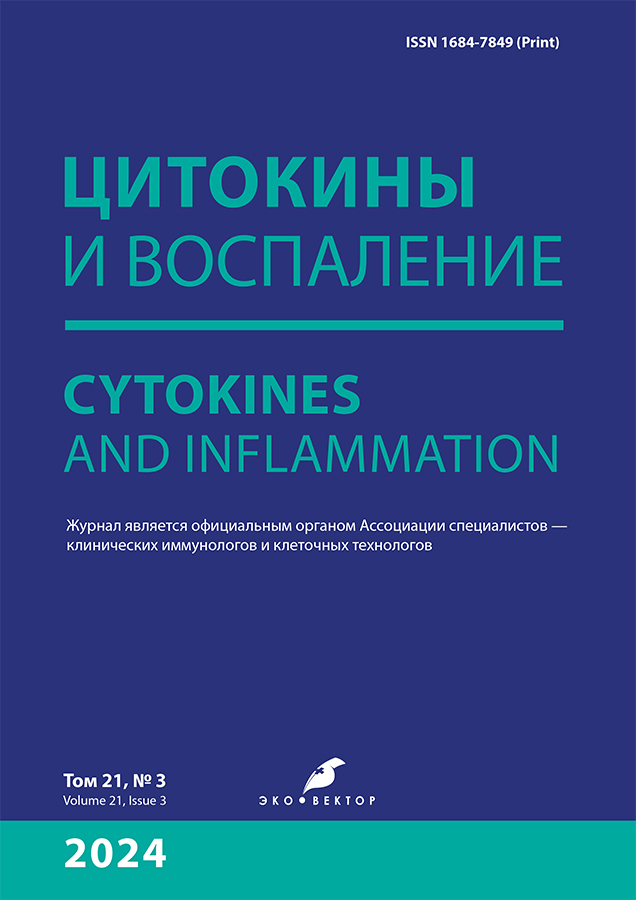Study of Recombinant Interleukin-1 Receptor Antagonist Compositions Biological Activity After Injection and Inhalation in Mouse Model of Pulmonary Inflammation
- Authors: Ischenko A.M.1, Nekrasova K.A.1, Laptev D.S.2, Bobkov D.V.2, Kolobov A.A.2, Simbirtsev A.S.1
-
Affiliations:
- State Research Institute of Highly Pure Biopreparations
- Research Institute of Hygiene, Occupational Pathology and Human Ecology
- Issue: Vol 21, No 3 (2024)
- Pages: 153-161
- Section: Original Study Articles
- URL: https://cijournal.ru/1684-7849/article/view/643495
- DOI: https://doi.org/10.17816/CI643495
- EDN: https://elibrary.ru/CPTDJX
- ID: 643495
Cite item
Abstract
BACKGROUND: The severity of respiratory distress syndrome is associated with the development of systemic multifactorial inflammatory processes leading to hyperinflammation. Proinflammatory cytokines, primarily interleukin-1 (IL-1), and reactive oxygen species substantially contribute to these pathological processes. The use of an interleukin-1 receptor antagonist (IL-1Ra) as an IL-1 blocker is a key first-line therapy for patients experiencing cytokine storm syndrome. The novelty of the approach under investigation lies in studying the effectiveness of inhaled administration of IL-1Ra, including its combined use with a reactive oxygen species inhibitor — superoxide dismutase (SOD).
AIM: To assess the efficacy of IL-1Ra administered parenterally and by inhalation, both as a standalone agent and in combination with SOD, in a bleomycin-induced acute respiratory distress syndrome model.
MATERIALS AND METHODS: Male BALB/c mice were used in the study. Respiratory distress syndrome was modeled by intraperitoneal administration of bleomycin at a dose of 2 mg/mouse on days 1, 8, and 15 of the experiment. The investigational drugs—a 10.0-mg/mL IL-1Ra solution and a 10.0-mg/mL IL-1Ra solution containing 0.4 mg/mL SOD—were administered to the experimental groups either subcutaneously or by inhalation at a dose of 2 mg/mouse daily for 15 days starting from day 1 of the experiment. Body weight, spirometry, histological studies, and animal survival were assessed.
RESULTS: Subcutaneous and inhalation administration of IL-1Ra + SOD, as well as subcutaneous administration of IL-1Ra, positively affected animal survival. Subcutaneous administration of IL-1Ra and IL-1Ra + SOD led to statistically significant improvements in indicators of external respiration in mice with bleomycin-induced intoxication. A reduction in destructive lung changes caused by intraperitoneal administration of bleomycin was observed in the experimental groups receiving inhaledIL-1Ra orIL-1Ra + SOD and in the group receiving subcutaneous IL-1Ra.
CONCLUSION: Both investigational products — IL-1Ra and IL-1Ra + SOD — administered by injection or inhalation demonstrated a positive effect in the treatment of respiratory distress syndrome induced by bleomycin in the mouse model.
Full Text
About the authors
Alexander M. Ischenko
State Research Institute of Highly Pure Biopreparations
Email: amischenko1946@mail.ru
ORCID iD: 0000-0002-6661-6145
SPIN-code: 5860-4216
Cand. Sci. (Biology)
Russian Federation, Saint PetersburgKsenia A. Nekrasova
State Research Institute of Highly Pure Biopreparations
Author for correspondence.
Email: k.a.nekrasova@hpb.spb.ru
ORCID iD: 0000-0002-0242-9615
SPIN-code: 9435-6100
Cand. Sci. (Biology)
Russian Federation, Saint PetersburgDenis S. Laptev
Research Institute of Hygiene, Occupational Pathology and Human Ecology
Email: laptev@gpech.ru
ORCID iD: 0000-0002-3960-3058
SPIN-code: 2873-5071
Cand. Sci. (Biology)
Russian Federation, Saint PetersburgDmitry V. Bobkov
Research Institute of Hygiene, Occupational Pathology and Human Ecology
Email: bobkov@gpech.ru
ORCID iD: 0000-0003-3989-0437
SPIN-code: 2673-8240
Russian Federation, Saint Petersburg
Alexander A. Kolobov
Research Institute of Hygiene, Occupational Pathology and Human Ecology
Email: aak1959@internet.ru
ORCID iD: 0000-0002-9222-6773
SPIN-code: 7019-2420
Dr. Sci. (Biology)
Russian Federation, Saint PetersburgAndrey S. Simbirtsev
State Research Institute of Highly Pure Biopreparations
Email: a.s.simbirtsev@hpb.spb.ru
ORCID iD: 0000-0002-8228-4240
SPIN-code: 2064-7584
MD, Dr. Sci. (Medicine), Professor
Russian Federation, Saint PetersburgReferences
- Bellani G, Laffey JG, Pham T, et al; LUNG SAFE Investigators; ESICM Trials Group. Epidemiology, patterns of care, and mortality for patients with acute respiratory distress syndrome in intensive care units in 50 countries. JAMA. 2016;315(8):788–800. doi: 10.1001/jama.2016.0291
- Matthay MA, Arabi Y, Arroliga AC, et al. A new global definition of acute respiratory distress syndrome. Am J Respir Crit Care Med. 2024;209(1):37–47. doi: 10.1164/rccm.202303-0558ws EDN: KGGZJL
- Matthay MA, Zemans RL, Zimmerman GA, et al. Acute respiratory distress syndrome. Nat Rev Dis Primers. 2019;5(18). doi: 10.1038/s41572-019-0069-0 EDN: WYILYX
- Butt Y, Kurdowska A, Allen TC. Acute lung injury: a clinical and molecular review. Arch Pathol Lab Med. 2016;140(4):345–350. doi: 10.5858/arpa.2015-0519-RA
- Bosch NA, Lee M-M, LeSieur MN, et al. Death due to irreversible hypoxemic respiratory failure in ARDSnet clinical trials. J Crit Care. 2022;67:85–87. doi: 10.1016/j.jcrc.2021.10.017 EDN: DQCOJN
- Ortiz LA, Dutreil M, Fattman C, et al. Interleukin 1 receptor antagonist mediates the antiinflammatory and antifibrotic effect of mesenchymal stem cells during lung injury. Proc Natl Acad Sci U S A. 2007;104(26):11002–11007. doi: 10.1073/pnas.0704421104
- Chang R, Mamun A, Dominic A, Le NT. SARS-CoV-2 mediated endothelial dysfunction: the potential role of chronic oxidative stress. Front Physiol. 2021;11:605908. doi: 10.3389/fphys.2020.605908 EDN: RTIKQO
- Khomich OA, Kochetkov SN, Bartosch B, Ivanov AV. Redox biology of respiratory viral infections. Viruses. 2018;10(8):392. doi: 10.3390/v10080392 EDN: SAZWEP
- Fernandes IG, de Brito CA, Dos Reis VMS, et al. SARS-CoV-2 and other respiratory viruses: what does oxidative stress have to do with it? Oxid Med Cell Longev. 2020;2020:8844280. doi: 10.1155/2020/8844280 EDN: OVXFWJ
- Suresh GK, Davis JM, Soll RF. Superoxide dismutase for preventing chronic lung disease in mechanically ventilated preterm infants. Cochrane Database Syst Rev. 2001;2001(1):CD001968. doi: 10.1002/14651858.CD001968
- Rosenfeld WN, Davis JM, Parton L, et al. Safety and pharmacokinetics of recombinant human superoxide dismutase administered intratracheally to premature neonates with respiratory distress syndrome. Pediatrics. 1996;97(6 Pt 1):811–817. EDN: CGFQYB
- Patent RUS № 2190400/ 21.06.99. Paramonov BA, Zinovyev EV, Churilova IV, et al. Treatment method for respiratory distress syndrome. Available from: https://yandex.ru/patents/doc/RU2190400C2_20021010?ysclid = m7nfv9vbo173755964 (In Russ.)
- Alzahrani B, Gaballa MMS, Tantawy AA, et al. Blocking Toll-like receptor 9 attenuates bleomycin-induced pulmonary injury. J Pathol Transl Med. 2022;56(2):81–91. doi: 10.4132/jptm.2021.12.27 EDN: PNRWCX
- Engeroff P, Belbézier A, Monsel A, Klatzmann D. Anakinra reduces lung inflammation in experimental acute lung injury. Immun Inflamm Dis. 2022;10(2):123–129. doi: 10.1002/iid3.548 EDN: JDITSO
- Meunier É, Aubin Vega M, Adam D, et al. Evaluation of interleukin-1 and interleukin-6 receptor antagonists in a murine model of acute lung injury. Exp Physiol. 2024;109(6):966–979. doi: 10.1113/EP091682 EDN: AYYWDB
Supplementary files












